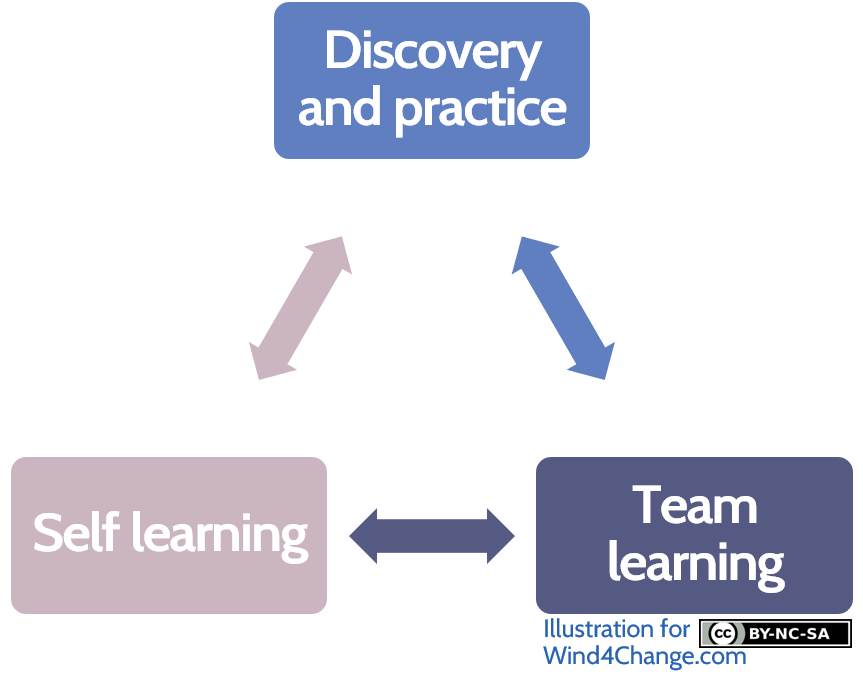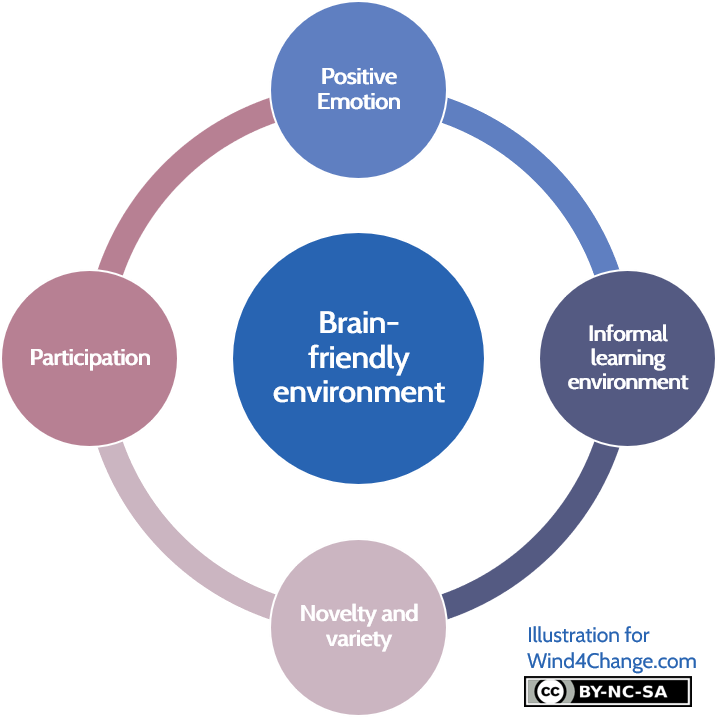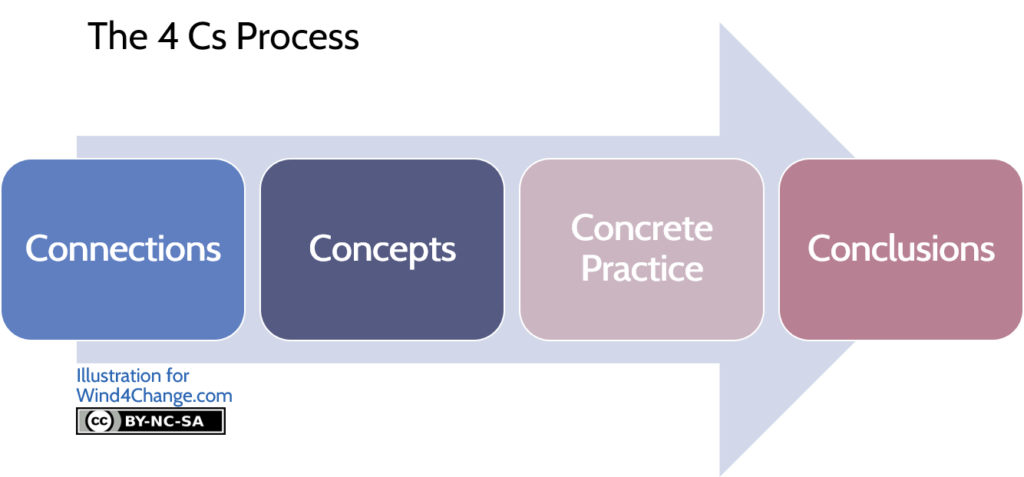What is the training from the back of the room? Furthermore, what is a brain-friendly training environment? At last, what are the 4 Cs: Connections, Concepts, Concrete Practice and Conclusions?
- What is "training from the back of the room"?
- What are the main principles of "training from the back of the room"?
- What is brain-friendly training environment from "training from the back of the room"?
- What are the 4 Cs from "training from the back of the room"?
- What’s next? Learn more on training, then coaching and change management
- Do you want to learn more about the "training from the back of the room"? Here are some valuable references
What is “training from the back of the room”?
“Training from the back of the room” is the name of the book and the approach developed by Sharon Bowman combining the best techniques on how to deliver a training. Clearly, this framework allows a learning with more impact and, after the training, more use of the knowledge acquired. It is true that, there are many other books and methods on the topic but this one is a good collection of the best practices and a nicely set format. Without a doubt, it is a reference on the matter.
What are the main principles of “training from the back of the room”?

Encourage discovery and practice from the learners
Firstly, the discovery should not be limited to the core and should allows making connections with existing knowledge or concerns of the learners.
Secondly, practice is key. Indeed, the format of the training should provide opportunities to experiment. Therefore failure is part of the game. Actually, failure is usually a better teacher than success.
This has a consequence on the learning environment. Indeed, you learn better in an informal environment where collaboration is encouraged, competition is neutralized, and mistakes are considered as a necessary part of the training process.
Leverage team learning
It is demonstrated that people learn a lot with and from the other learners. Couple practices support that:
- Provide challenges to groups, not individuals.
- Make time and room for conversation between learning peers.
- For a given question or need for clarification, have one learner explains to the other. In truth, you learn a lot by teaching to someone else.
Enable self learning
Provide additional resources for people to learn by themselves. It can be before the training as a warm up, during or after.
What is brain-friendly training environment from “training from the back of the room”?
In order to facilitate the training, setting an environment that will support learning, also called a brain-friendly environment, is critical. Here are the principles of a brain-friendly training environment:

Positive emotion
Emotions are a powerful lever for learning. In addition to the rational part of your brain, the emotional part should be mobilized. Positive emotions of course! They will leave a pleasant memory that will be more likely to last.
In addition, it is all the learning environment that should be positively charged. For example, learners should feel competent, respected and smart to raise in a positive spiral. The better they feel, the smarter they actually become and eager to learn. On the contrary, stress context decreases learning capacity as people tend to come back to routine behaviors and old and totally mastered knowledge.
Informal learning environments
Learners should feel comfortable in their training space. To illustrate that, typical set up includes round tables, colored paper and pens for each group, posters on walls, snack food and beverages on a corner of the room.
Novelty and variety
Steer the level of attention
- Information delivery should be 10 minutes maximum.
- In addition, make sure that you have 4 times 1-minute break per hour
- Then, have learners move. Indeed simply standing up after sitting awhile increases blood flow, then oxygen to the brain, by about 15 to 20%. Cognitive capacities rise and so memory.
Enforce variety of stimuli and instructions
Firstly, mix stimuli and the types of stimulus:
- Auditory stimulation: reading, discussion, changes in tones or volume of voice, rhythm and even music!
- Visual stimulation: use colors, shapes, charts, slides, images, metaphors and anything that helps to create strong mental pictures of important concepts.
- Kin-esthetic stimulation: have learners move, participate including with gestures like voting to answer questions. To illustrate, have them write and manipulate learning materials like highlighting, underlining or circling important points.
Secondly, mix instructional strategies picking from:
- Whole group learning like brief lectures, video, question-and-answer time, group discussions.
- Individual or small group learning like reading, writing, quiet reflection time and games.
Channel participation and collaboration
Set the frame to support active participation and collaboration:
- Firstly, give the learners just enough information to start, then step aside for them to learn elaborating on the information you provided.
- Secondly, propose a frame for self-learning activity with clear guidelines: the purpose, the time allocated, the expected output from participation.
- Thirdly, increase the level of difficulty of the activities as they become more:
- skilled with the training material,
- comfortable with this new learning approach,
- psychologically safe in their learning environment.
Make them create their own learning:
- For instance, propose a list of introductory activities.
- Or suggest a collection of direct instruction strategies.
- Also, give learners a timeline and a choice of format for content review.
- And even, hand them over a specific part of the training for them to lead, but with proper guidelines so they do not get lost.
What are the 4 Cs from “training from the back of the room”?
The framework training from the back of the room comes with a process in 4 key steps on how to deliver teaching:

Connections
In this step, learners make connections with the training topic in 3 different ways:
- To other learners, positively and meaningfully relatively to the training topic.
- To the topic, with what they already know, or think they know.
- At last, to their own learning goals, and what they personally want to take away from the training and to apply after, when back in their day to day life.
Concepts
In “training from the back of the room” concepts remain an important step. But to start with, it should mix the learning approaches and be multi-sensory ways. In addition, the concepts should be limited to the need-to-know information necessary for learners’ success. Avoid overloading them with too much information that will loose them, that they will never use and that will blur the focus from the essential.
Here are some good practices can help to move this step from the traditional inefficient concepts lecture:
- To start with, the ten-minute rule: this is a reminder to divide concepts step into small 10-minute time period of lecture maximum.
- Then, interactive lecture strategies: between one-way lecture time periods, involve learners varying types of interactions.
- To finish, one-minute reviews: these are short time periods to review learning either alone or in group with various format.
- By the flow, concept maps also called graphic organizers: these are note-taking materials that are visually appealing and support learners’ long-term memory. Concept maps:
- Create visual images of important concepts.
- Use a variety of ways of learning: visual/spatial, linguistic, logical and kin-esthetic.
- Engage both hemispheres of brain.
- Lengthen long-term memory of important information.
- Make learners remaining involved and engaged during the lecture phase.
- Leave the training with a visual reminder of what they learned. Furthermore, they can use it as an information resource afterwards.
Concrete Practice
During this step, learners actively practice the new skills or they participate in an active review of the new knowledge they have learned.
3 elements are required for an effective practice:
- All learners participate actively.
- To continue, there are interdependences between learners requiring collaboration.
- At last, each of them are accountable individually for the outcome of the practice.
Conclusions
Conclusions are a short step, learner-focused with closing activities in which learners perform the following regarding what they have learned:
- Summarize
- Evaluate. Donald Kirkpatrick’s learning evaluation model is an idea of format to do so:
- Emotions (feelings): “How do participants feel about what they learned?”
- Knowledge (information): “What do participants remember about what they learned?”
- Behavior (skills): “Can participants use what they learned?”
- Return on Investment (benefit to the company): “How does the company benefit from what participants learned?”
- Make an action plan commitment to apply.
- Celebrate the learning experience. Like connections that engage learners from the moment they walk into the training room, conclusions engage learners up after the moment they leave.
What’s next? Learn more on training, then coaching and change management
Discover my post about the Cognitive Load Theory.
Check my posts about:
Do you want to learn more about the “training from the back of the room”? Here are some valuable references
- The book of Sharon Bowman: Training from the back of the room!
- The website of Sharon Bowman.
- A good post about brain-based learning.
